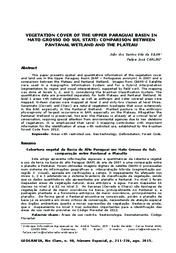Vegetation cover of the Upper Paraguai Basin in Mato Grosso do Sul State: comparison between Pantanal wetland and the plateau.
Vegetation cover of the Upper Paraguai Basin in Mato Grosso do Sul State: comparison between Pantanal wetland and the plateau.
Autoria: SILVA, J. dos S. V. da; CARLINI, F. J.
Resumo: This paper presents spatial and quantitative information of the vegetation cover and land use in the Upper Paraguay Basin (BAP ñ Portuguese acronym) in 2007 and a comparison between the Plateau and Pantanal Wetland. Images from CBERS-2 Satellite were used in a Geographic Information System and for a hybrid interpretation (segmentation by region and visual interpretation), supported by field work. The mapping was done at levels 1, 2, and 3, considering the Brazilian Classification System. The quantitative data are presented separately for both Plateau and Pantanal Wetland. At level 1 areas with natural vegetation, as well as anthropic and water covered areas were mapped. Sixteen classes were mapped at level 2 and sixty-two classes at level three. Savannahs (Cerrado and Chaco) are natural vegetation typologies that occur extensively in the BAP, especially in the Pantanal Wetland. Planted pasture is the anthropic physiognomy of largest occurrence in BAP, especially on the Plateau. Altogether the Pantanal Wetland is preserved, however the Plateau is already at a critical level of conservation, requiring special attention from environmental agencies due to new deletions of vegetation. It is emphasized that Level 3 mapping contributes with important information for the identification of areas with restricted use, established by the Brazilian Forest Code from 2012.
Ano de publicação: 2015
Tipo de publicação: Artigo de periódico
Unidade: Embrapa Agricultura Digital
Palavras-chave: Areas with restricted use, Código florestal, Desmatamento, Forest code, Geotechnology, Geotecnologia, Áreas de uso restrito
Observações
1 - Por padrão são exibidas publicações dos últimos 20 anos. Para encontrar publicações mais antigas, configure o filtro ano de publicação, colocando o ano a partir do qual você deseja encontrar publicações. O filtro está na coluna da esquerda na busca acima.
2 - Para ler algumas publicações da Embrapa (apenas as que estão em formato ePub), é necessário ter, no celular ou computador, um desses softwares gratuitos. Sistemas Android: Google Play Livros; IOS: iBooks; Windows e Linux: software Calibre.
Acesse outras publicações
Acesse a Base de Dados da Pesquisa Agropecuária (BDPA) para consultar o acervo completo das bibliotecas da Embrapa.

